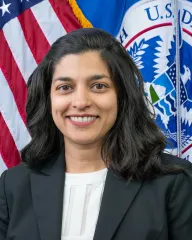Guest post by Sarah Mahmood, Technical Director of the Technology Centers Division in the Science and Technology Directorate (S&T) Office of Science and Engineering

S&T consists of a diverse collection of people bringing their unique perspectives and ideas to the mission of making America safer. These team members come from a wide array of races, ethnicities, genders, sexual orientations, cultural backgrounds, and professional disciplines and I’m proud to be one of them.
In recognition of International Women in Engineering Day, I was invited to share what my job as an S&T engineer, who also happens to be a woman, is like. I was asked to consider the following questions and here’s how I responded:
What’s your educational background?
I have both bachelor’s and master’s degrees in electrical engineering from Virginia Tech. Go Hokies!
How did you know that you wanted to be an engineer?
It started with “Bring Your Kids to Work” days with my dad. He is a civil and environmental engineer and was always working on really interesting projects around the world, such as in Kuwait and remote regions in Kazakhstan. I loved going into his office and seeing the giant print-outs of drawings, schematics, and renderings. It was all so fascinating to me and seemed like very impactful work. I loved knowing that it would go from these ideas and designs on paper to real-life creations.
Another motivating factor was being told that I couldn’t do engineering or wouldn’t be successful because I was a girl. I wanted to prove those folks wrong. Whenever things got challenging at school, that’s what I would use to carry me through.
Why is engineering important?
Engineers are problem solvers. They are kind of like the foundation that’s needed across countless domains to bring research, innovation, and technology out of the labs and into our lives by making these things work.
What brought you to S&T?
I was looking for a change when I was working at another federal agency when I stumbled across S&T. I hadn’t heard about it before, but once I learned more I felt drawn to the mission.
How are you able to use your engineering expertise to further the S&T mission?
I’ve been fortunate enough to be able to apply my engineering background to a number of different projects throughout the years at S&T, from grid resiliency to critical infrastructure security. I think a technical scientific or engineering background enables you to have a framework to use to engage on new challenges—even if you don’t have specific expertise in that space just yet or it’s not exactly what you studied in college—making it easier to grasp and learn.
How do you describe your job to friends and family?
It’s the best of all worlds … being at the cutting edge of research and development and using those developments to secure, protect, and defend the homeland.
What are you working on right now that you’re excited about?
I’m knee-deep in working with our subject matter experts to revise the Technology Centers research agenda. I think this is really exciting because it sets a vision for the future of where science and technology efforts are going in the next 3 to 5 years and how it matters to the Department of Homeland Security. You really get a sense of how much is happening throughout the world, how science and technology is constantly evolving, and how in some cases these developments overlap, intersect, and converge to create new capabilities and opportunities for more research. There’s no shortage of developments being made or research that needs to be done!
What’s your favorite part of your job?
My favorite part of the job is working alongside my colleagues at S&T and learning so much from their deep expertise across so many different subject areas. I love seeing problems through different perspectives. And seeing the reach and impact of our research. It may not always be clear, but our work really does have significant impact in building knowledge—not just for DHS, but within our technical communities of interest as well.
Another aspect is engaging with researchers and private industry to learn and hear about the innovative approaches they are taking to solve complicated problems.
What’s something about your time at S&T that has surprised you?
This may sound silly, but it’s how long I’ve been here! 14 years … and no two days have been the same. I’ve been here this long (and hope to be here for another 14) because I really do find the work interesting and rewarding. The mission is compelling. There are always new developments, new research, new projects, and new opportunities … and continuous learning.
What advice do you have for an aspiring woman in STEM?
Ask questions, learn from the experts around you, and say yes to opportunities that push your limits. You can’t learn it all from the textbooks, so don’t be afraid to get your hands dirty.
--
Cheers to all the female engineers at S&T and beyond who have gotten their hands dirty in the best ways. We have much to learn from you, and you are making a lasting impact on our world. Learn more about Sarah’s work in the Technology Centers and read more testimonials from S&T colleagues in our recent International Women’s Day blog.
